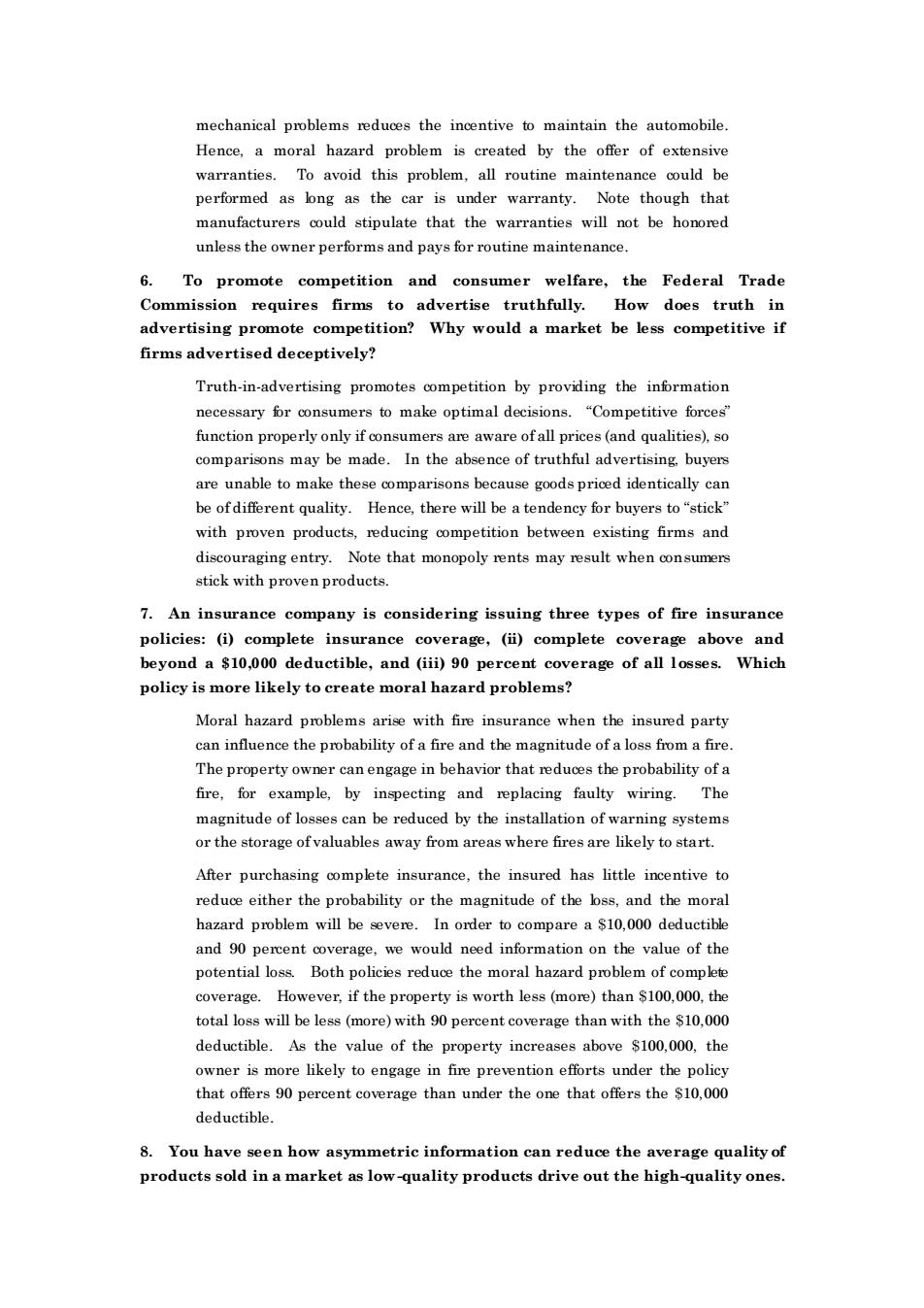正在加载图片...

mechanical problems reduces the incentive to maintain the automobile. Hence,a moral hazard problem is created by the offer of extensive warranties this problem,all routine maintenance ould performed as long as the car is under warranty. Note though that manufacturers oould stipulate that the warranties will not be honored unless the owner performs and pays for routine maintenance. 6.To promote competition and consumer welfare.the Federal Trade Commission requires firms to advertise truthfully. How does truth in advertising ote etition?Why would a a market be les mpetitive if firms advertised deceptively? Truth-in-advertising promotes competition by providing the infrmation necessary for consumers to make optimal decisions."Competitive forces" function properly only if consumers are aware ofall prices (and qualities).so comparisons may be made.In the absence of truthful advertising.buvers are nable to make thes be ofdifferent quality.Hence,there will be a tendency for buyers to"stick with proven products,reducing competition between existing firms and discouraging entry.Note that monopoly rents may result when consumers stick with proven products. 7.An insurance company is considering issuing three types of fire insurance policies:(i)complete ins rance age,(ii) co nplete rage above beyond a $10,000 deductible,and (iii)90 percent coverage of all losses. Which policy is more likely to create moral hazard problems? Moral hazard problems arise with fire insurance when the insured party can influence the probability of a fire and the magnitude of a loss from a fire. The property owner can engage in behavior that reduces the probability of a fire,for example,by inspecting and replacing faulty wiring. The magnitude of l ses can be reduced by the installation of warning systems or the storage of valuables away from areas where fires are likely to start. After purchasing complte insurance,the insured has little incentive to reduce either the probability or the magnitude of the loss.and the moral hazard problem will be severe.In order to compare a s10.000 deductible and 90 percent coverage,we would need information on the value of the potential os Both d pm oblem of c coverage. However,if the property is worth less(more)than $100,000,the total loss will be less (more)with 90 percent coverage than with the $10.000 deductible.As the value of the property increases above $100,000.the owner is more likely to engage in fire ention efforts under the policy that coverag than und he on that offo th $10 000 deductible 8.You have seen how asymmetric information can reduce the average quality of products sold in a market as low-quality products drive out the high-quality ones mechanical problems reduces the incentive to maintain the automobile. Hence, a moral hazard problem is created by the offer of extensive warranties. To avoid this problem, all routine maintenance could be performed as long as the car is under warranty. Note though that manufacturers could stipulate that the warranties will not be honored unless the owner performs and pays for routine maintenance. 6. To promote competition and consumer welfare, the Federal Trade Commission requires firms to advertise truthfully. How does truth in advertising promote competition? Why would a market be less competitive if firms advertised deceptively? Truth-in-advertising promotes competition by providing the information necessary for consumers to make optimal decisions. “Competitive forces” function properly only if consumers are aware of all prices (and qualities), so comparisons may be made. In the absence of truthful advertising, buyers are unable to make these comparisons because goods priced identically can be of different quality. Hence, there will be a tendency for buyers to “stick” with proven products, reducing competition between existing firms and discouraging entry. Note that monopoly rents may result when consumers stick with proven products. 7. An insurance company is considering issuing three types of fire insurance policies: (i) complete insurance coverage, (ii) complete coverage above and beyond a $10,000 deductible, and (iii) 90 percent coverage of all losses. Which policy is more likely to create moral hazard problems? Moral hazard problems arise with fire insurance when the insured party can influence the probability of a fire and the magnitude of a loss from a fire. The property owner can engage in behavior that reduces the probability of a fire, for example, by inspecting and replacing faulty wiring. The magnitude of losses can be reduced by the installation of warning systems or the storage of valuables away from areas where fires are likely to start. After purchasing complete insurance, the insured has little incentive to reduce either the probability or the magnitude of the loss, and the moral hazard problem will be severe. In order to compare a $10,000 deductible and 90 percent coverage, we would need information on the value of the potential loss. Both policies reduce the moral hazard problem of complete coverage. However, if the property is worth less (more) than $100,000, the total loss will be less (more) with 90 percent coverage than with the $10,000 deductible. As the value of the property increases above $100,000, the owner is more likely to engage in fire prevention efforts under the policy that offers 90 percent coverage than under the one that offers the $10,000 deductible. 8. You have seen how asymmetric information can reduce the average quality of products sold in a market as low-quality products drive out the high-quality ones